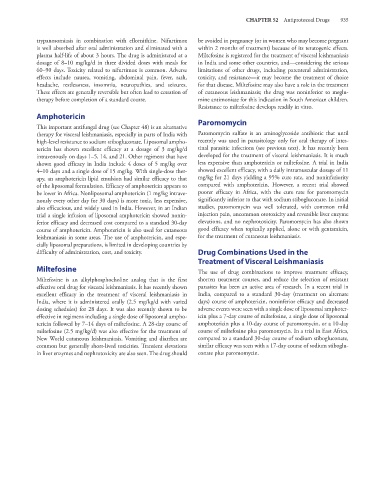Page 949 - Basic _ Clinical Pharmacology ( PDFDrive )
P. 949
CHAPTER 52 Antiprotozoal Drugs 935
trypanosomiasis in combination with eflornithine. Nifurtimox be avoided in pregnancy (or in women who may become pregnant
is well absorbed after oral administration and eliminated with a within 2 months of treatment) because of its teratogenic effects.
plasma half-life of about 3 hours. The drug is administered at a Miltefosine is registered for the treatment of visceral leishmaniasis
dosage of 8–10 mg/kg/d in three divided doses with meals for in India and some other countries, and—considering the serious
60–90 days. Toxicity related to nifurtimox is common. Adverse limitations of other drugs, including parenteral administration,
effects include nausea, vomiting, abdominal pain, fever, rash, toxicity, and resistance—it may become the treatment of choice
headache, restlessness, insomnia, neuropathies, and seizures. for that disease. Miltefosine may also have a role in the treatment
These effects are generally reversible but often lead to cessation of of cutaneous leishmaniasis; the drug was noninferior to meglu-
therapy before completion of a standard course. mine antimoniate for this indication in South American children.
Resistance to miltefosine develops readily in vitro.
Amphotericin
This important antifungal drug (see Chapter 48) is an alternative Paromomycin
therapy for visceral leishmaniasis, especially in parts of India with Paromomycin sulfate is an aminoglycoside antibiotic that until
high-level resistance to sodium stibogluconate. Liposomal ampho- recently was used in parasitology only for oral therapy of intes-
tericin has shown excellent efficacy at a dosage of 3 mg/kg/d tinal parasitic infections (see previous text). It has recently been
intravenously on days 1–5, 14, and 21. Other regimens that have developed for the treatment of visceral leishmaniasis. It is much
shown good efficacy in India include 4 doses of 5 mg/kg over less expensive than amphotericin or miltefosine. A trial in India
4–10 days and a single dose of 15 mg/kg. With single-dose ther- showed excellent efficacy, with a daily intramuscular dosage of 11
apy, an amphotericin lipid emulsion had similar efficacy to that mg/kg for 21 days yielding a 95% cure rate, and noninferiority
of the liposomal formulation. Efficacy of amphotericin appears to compared with amphotericin. However, a recent trial showed
be lower in Africa. Nonliposomal amphotericin (1 mg/kg intrave- poorer efficacy in Africa, with the cure rate for paromomycin
nously every other day for 30 days) is more toxic, less expensive, significantly inferior to that with sodium stibogluconate. In initial
also efficacious, and widely used in India. However, in an Indian studies, paromomycin was well tolerated, with common mild
trial a single infusion of liposomal amphotericin showed nonin- injection pain, uncommon ototoxicity and reversible liver enzyme
ferior efficacy and decreased cost compared to a standard 30-day elevations, and no nephrotoxicity. Paromomycin has also shown
course of amphotericin. Amphotericin is also used for cutaneous good efficacy when topically applied, alone or with gentamicin,
leishmaniasis in some areas. The use of amphotericin, and espe- for the treatment of cutaneous leishmaniasis.
cially liposomal preparations, is limited in developing countries by
difficulty of administration, cost, and toxicity. Drug Combinations Used in the
Treatment of Visceral Leishmaniasis
Miltefosine The use of drug combinations to improve treatment efficacy,
Miltefosine is an alkylphosphocholine analog that is the first shorten treatment courses, and reduce the selection of resistant
effective oral drug for visceral leishmaniasis. It has recently shown parasites has been an active area of research. In a recent trial in
excellent efficacy in the treatment of visceral leishmaniasis in India, compared to a standard 30-day (treatment on alternate
India, where it is administered orally (2.5 mg/kg/d with varied days) course of amphotericin, noninferior efficacy and decreased
dosing schedules) for 28 days. It was also recently shown to be adverse events were seen with a single dose of liposomal amphoter-
effective in regimens including a single dose of liposomal ampho- icin plus a 7-day course of miltefosine, a single dose of liposomal
tericin followed by 7–14 days of miltefosine. A 28-day course of amphotericin plus a 10-day course of paromomycin, or a 10-day
miltefosine (2.5 mg/kg/d) was also effective for the treatment of course of miltefosine plus paromomycin. In a trial in East Africa,
New World cutaneous leishmaniasis. Vomiting and diarrhea are compared to a standard 30-day course of sodium stibogluconate,
common but generally short-lived toxicities. Transient elevations similar efficacy was seen with a 17-day course of sodium stiboglu-
in liver enzymes and nephrotoxicity are also seen. The drug should conate plus paromomycin.

